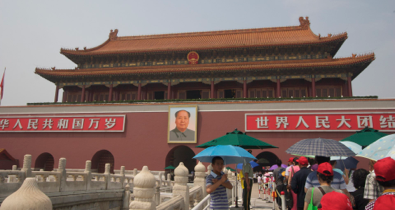
6/26/2010
 |
During my June 2010 trip to
China, I visited the Summer Palace, the Great Wall, and
the Forbidden City during my limited tourist time.
These are my pleasant memories. |
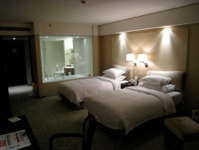 During my visit to China, I had about a
day and a half to play tourist. One day at the beginning of my
visit, which I had officially set aside to fight the 12 hours of jet
lag between Boston and Beijing, and a half-day between returning
from Changsha and embarking on my flight back to the US. (The day to
get over jet lag was way too little!) On my first day in
Beijing, three of us had arranged a tour to see the Great Wall and
the Summer Palace, two of the "must see" sights of Beijing.
During my visit to China, I had about a
day and a half to play tourist. One day at the beginning of my
visit, which I had officially set aside to fight the 12 hours of jet
lag between Boston and Beijing, and a half-day between returning
from Changsha and embarking on my flight back to the US. (The day to
get over jet lag was way too little!) On my first day in
Beijing, three of us had arranged a tour to see the Great Wall and
the Summer Palace, two of the "must see" sights of Beijing.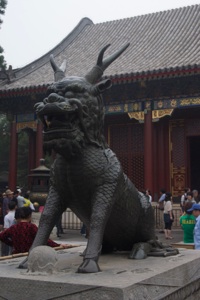 Our tour guide met us around
7:30am, and he and his minibus driver took us around for the day. We
first drove to the Summer Palace, which is a rather late set of much
older style Imperial buildings dating from the late 19th and early
20th centuries, where the hand of the dowager and regent Cixi shows
paramount. The old Summer Palace, which was on a nearby but
different plot of land, was razed in the Opium Wars by some British
general, who thought that doing so would "bring some sense" to the
emperor. That site remains today in a destroyed state,
reminding the Chinese how bad it can be to be powerless against the
outside world. The place we visited was actually built in the
18th century and it, too, was burned in the opium wars and the Boxer
rebellion, but then rebuilt under Cixi’s rule. She is said to
have embezzled about thirty-six million troy ounces of silver for
the reconstruction, which had been set aside to build the Chinese
Imperial Navy instead. This later proved catastrophic in wars
against Japan, which did invest in a modern navy, whereas China was
left defenseless.
Our tour guide met us around
7:30am, and he and his minibus driver took us around for the day. We
first drove to the Summer Palace, which is a rather late set of much
older style Imperial buildings dating from the late 19th and early
20th centuries, where the hand of the dowager and regent Cixi shows
paramount. The old Summer Palace, which was on a nearby but
different plot of land, was razed in the Opium Wars by some British
general, who thought that doing so would "bring some sense" to the
emperor. That site remains today in a destroyed state,
reminding the Chinese how bad it can be to be powerless against the
outside world. The place we visited was actually built in the
18th century and it, too, was burned in the opium wars and the Boxer
rebellion, but then rebuilt under Cixi’s rule. She is said to
have embezzled about thirty-six million troy ounces of silver for
the reconstruction, which had been set aside to build the Chinese
Imperial Navy instead. This later proved catastrophic in wars
against Japan, which did invest in a modern navy, whereas China was
left defenseless.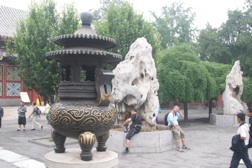 The Summer Palace is built
along the edges of a huge man-made lake, a beautiful sight, and a
setting for an island with its own shrine, bridges, and dragon
boats. The palace buildings are in the Imperial Chinese style,
with curved tile roofs and brightly painted wooden beams. Many
statues of mythical beasts, great bronze vessels, and huge
philosopher stones populate the grounds. The long gallery, a
spectacular covered walk taking a sinuous course next to a row of
trees, looking out on the lake on one side and a tranquil pool on
the other, is one of the Palace’s great features. It’s in the photo
above. I’ve enjoyed the Huntington’s recent construction of a
Chinese Garden in San Marino, California; this park has many of the
features they are surely trying to emulate, on a much smaller scale.
The Summer Palace is built
along the edges of a huge man-made lake, a beautiful sight, and a
setting for an island with its own shrine, bridges, and dragon
boats. The palace buildings are in the Imperial Chinese style,
with curved tile roofs and brightly painted wooden beams. Many
statues of mythical beasts, great bronze vessels, and huge
philosopher stones populate the grounds. The long gallery, a
spectacular covered walk taking a sinuous course next to a row of
trees, looking out on the lake on one side and a tranquil pool on
the other, is one of the Palace’s great features. It’s in the photo
above. I’ve enjoyed the Huntington’s recent construction of a
Chinese Garden in San Marino, California; this park has many of the
features they are surely trying to emulate, on a much smaller scale.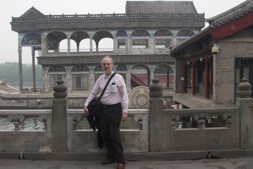 Another of Cixi’s great follies is a marble boat, cut
from a single giant block of marble, serving as an outdoor place to
entertain. It combines a Western architectural style, the form
of a dragon boat, and the total immobility of a giant block of
rock. My photo on the right, taken by our tour guide, shows
its rather garish form, as well as my burden of photo gear.
Another of Cixi’s great follies is a marble boat, cut
from a single giant block of marble, serving as an outdoor place to
entertain. It combines a Western architectural style, the form
of a dragon boat, and the total immobility of a giant block of
rock. My photo on the right, taken by our tour guide, shows
its rather garish form, as well as my burden of photo gear. The Great Wall at Badaling
The Great Wall at Badaling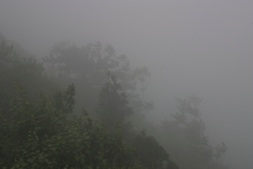 The Wall is massive. At the section I visited,
it is about 25 feet tall, 16 feet wide, and runs sinuously along the
ridge of rather rugged hills. Facing outward, it is lined with
a continuous wall arrayed with excellent places from which to shoot
arrows downward at any troops brave enough to endure the fire as
they have to climb up a mountain side just to get to the base of the
wall, and then find a way to climb up to the top. There are
also periodic turrets, which provide higher and more protected
firing places. The wall is made of solid brick and stones, and there
is no ground near it from which to mount a charge with a battering
ram, so I think before the era of gunpowder (used as a weapon, not
for fireworks), it would have been close to impregnable. The
wall curves not only from side to side but also up and down as it
follows the ridge line.
The Wall is massive. At the section I visited,
it is about 25 feet tall, 16 feet wide, and runs sinuously along the
ridge of rather rugged hills. Facing outward, it is lined with
a continuous wall arrayed with excellent places from which to shoot
arrows downward at any troops brave enough to endure the fire as
they have to climb up a mountain side just to get to the base of the
wall, and then find a way to climb up to the top. There are
also periodic turrets, which provide higher and more protected
firing places. The wall is made of solid brick and stones, and there
is no ground near it from which to mount a charge with a battering
ram, so I think before the era of gunpowder (used as a weapon, not
for fireworks), it would have been close to impregnable. The
wall curves not only from side to side but also up and down as it
follows the ridge line.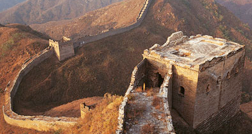 I was expecting to see and
photograph a scene much like the one to the right (a standard
publicity photo), or the beautiful shots of President Obama recently
visiting, with the Great Wall stretching off to infinity behind him
on a radiant, clear day. Alas, we were there in the fog, which
was mysterious and magical, but where infinity started at about 50
to 100 feet. Even pictures of people near me look really hazy.
Although not this intense, I experienced the same kind of fog
throughout my stay in Beijing. Fortunately, it seemed due to natural
humidity in the air, not the tremendous pollution for which the city
is famous. My Chinese students assure me that before the cleanup for
the Olympics last year, it would have been smog.
I was expecting to see and
photograph a scene much like the one to the right (a standard
publicity photo), or the beautiful shots of President Obama recently
visiting, with the Great Wall stretching off to infinity behind him
on a radiant, clear day. Alas, we were there in the fog, which
was mysterious and magical, but where infinity started at about 50
to 100 feet. Even pictures of people near me look really hazy.
Although not this intense, I experienced the same kind of fog
throughout my stay in Beijing. Fortunately, it seemed due to natural
humidity in the air, not the tremendous pollution for which the city
is famous. My Chinese students assure me that before the cleanup for
the Olympics last year, it would have been smog.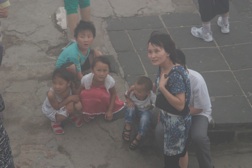
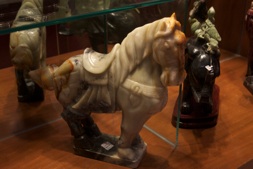
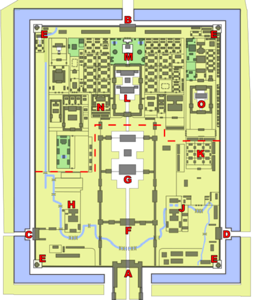 The Forbidden City
The Forbidden City Walking north under the huge
picture of Mao at the Tien An Men gate, you enter a front courtyard,
full of vendors selling postcards, digital memory cards, and soft
drinks. Every third person is a student offering to guide you
through the Palace for a pittance. (I suddenly developed
language amnesia and could speak only Hungarian, until I actually
ran into a Hungarian tour guide!) You enter the Forbidden City
itself through the Meridian Gate (A on the diagram), a formidable
and easily defended U-shaped structure that is clearly meant to
impress with its immensity and severity. This is where passage
to those without court business was “forbidden”.
Walking north under the huge
picture of Mao at the Tien An Men gate, you enter a front courtyard,
full of vendors selling postcards, digital memory cards, and soft
drinks. Every third person is a student offering to guide you
through the Palace for a pittance. (I suddenly developed
language amnesia and could speak only Hungarian, until I actually
ran into a Hungarian tour guide!) You enter the Forbidden City
itself through the Meridian Gate (A on the diagram), a formidable
and easily defended U-shaped structure that is clearly meant to
impress with its immensity and severity. This is where passage
to those without court business was “forbidden”. 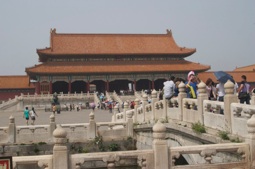 The first courtyard is the one I always
think of as representing the Forbidden City because of its iconic
stream with the five parallel stone bridges that usually provides a
backdrop to guards marching or foreign dignitaries entering.
It is immense and imposing, between the back of the Meridian Gate
and the Gate of Supreme Harmony (Tai He Men), which was the outer
border of where the Emperor would receive reports from functionaries
or issue decrees. The square is also bordered by impressive gates on
the east and west sides, leading to military and literary portions
of the Forbidden City.
The first courtyard is the one I always
think of as representing the Forbidden City because of its iconic
stream with the five parallel stone bridges that usually provides a
backdrop to guards marching or foreign dignitaries entering.
It is immense and imposing, between the back of the Meridian Gate
and the Gate of Supreme Harmony (Tai He Men), which was the outer
border of where the Emperor would receive reports from functionaries
or issue decrees. The square is also bordered by impressive gates on
the east and west sides, leading to military and literary portions
of the Forbidden City. 
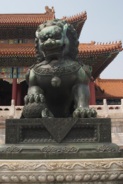 Two bronze lions represent the Empress and
Emperor. The female has her paw on a cub, who squirms on his
back; the male has his paw on an orb, representing his rule.
In fact, many depictions of rulers show the male and female in some
mythical representation. At the Summer Palace, we saw pairs of
Phoenix and Dragons representing the Empress and Emperor.
Two bronze lions represent the Empress and
Emperor. The female has her paw on a cub, who squirms on his
back; the male has his paw on an orb, representing his rule.
In fact, many depictions of rulers show the male and female in some
mythical representation. At the Summer Palace, we saw pairs of
Phoenix and Dragons representing the Empress and Emperor.
 The next courtyard leads to the Hall of
Supreme Harmony (Tai He Dian). The photo on the right shows a stone
carved ramp flanked by stairs from the rear of Tai He Men, a vast
courtyard, then leading up a tiered series of terraces to this
imposing Hall. Here some Emperors and Empresses were
enthroned, celebrations were held for major holidays, new civil
servants were announced, and generals were sent out to war. I see
the Hall as very colorful and even garish, but I’m continually
enchanted by the texture, lines and colors of the tile roofs. In the
second row, below, are the throne, and a bird (crane?) and sundial,
attesting to the power of the Emperor.
The next courtyard leads to the Hall of
Supreme Harmony (Tai He Dian). The photo on the right shows a stone
carved ramp flanked by stairs from the rear of Tai He Men, a vast
courtyard, then leading up a tiered series of terraces to this
imposing Hall. Here some Emperors and Empresses were
enthroned, celebrations were held for major holidays, new civil
servants were announced, and generals were sent out to war. I see
the Hall as very colorful and even garish, but I’m continually
enchanted by the texture, lines and colors of the tile roofs. In the
second row, below, are the throne, and a bird (crane?) and sundial,
attesting to the power of the Emperor.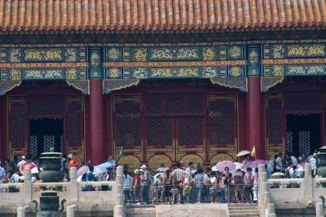 |
 |
||
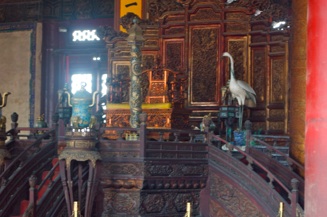 |
|
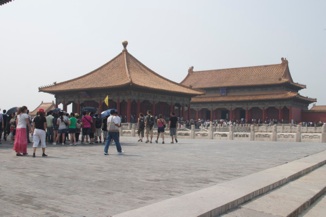 |
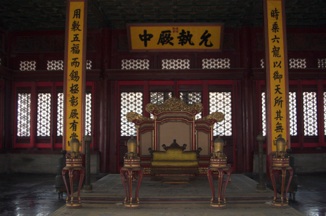 |
||
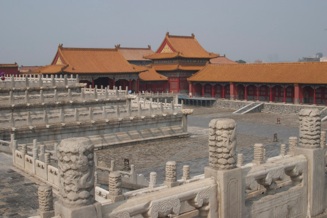 |
|
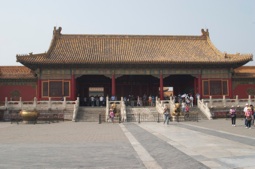 The
next courtyard, another imposing place with complex tiered terraces,
leads to the smaller Hall of Central Harmony (Zhong He Dian) in the
center and the larger Hall of Preserved Harmony (Bao He Dian).
“Central” served as a kind of vestry for the Emperor preparing for
his official functions. “Preserved” had served at various times in
history as a residence, banquet hall, wedding site, and examination
room.
The
next courtyard, another imposing place with complex tiered terraces,
leads to the smaller Hall of Central Harmony (Zhong He Dian) in the
center and the larger Hall of Preserved Harmony (Bao He Dian).
“Central” served as a kind of vestry for the Emperor preparing for
his official functions. “Preserved” had served at various times in
history as a residence, banquet hall, wedding site, and examination
room. |
 |
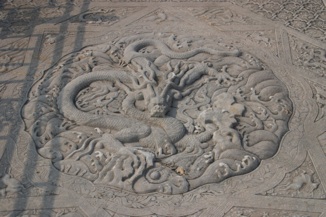 |
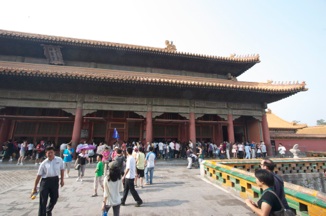 |
 |
 |
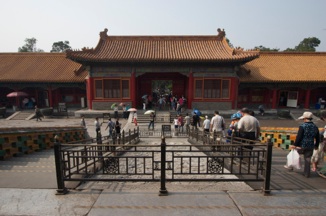 |
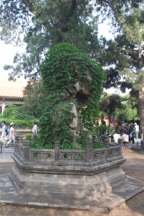 |
 |
|||
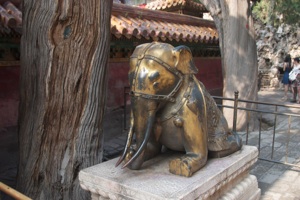 |
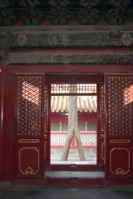 |
 |
|||
 |
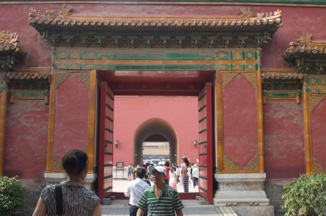 |
||||
 Having
traversed the main axis, I then strolled into the west side of the
Forbidden City, which served as the residence of the empress and
concubines, and held countless little courtyards devoted to
education, the arts, and treasures. The scale here is more
intimate and charming, and the tiles, plants and wooden details are
quite beautiful. But the many severe walls, gates with strong
logs to bar them shut, and long alleyways where an attacker could be
trapped in a deadly ambush remind me of the fear of instability and
the definite defensive role of the Palace grounds.
Having
traversed the main axis, I then strolled into the west side of the
Forbidden City, which served as the residence of the empress and
concubines, and held countless little courtyards devoted to
education, the arts, and treasures. The scale here is more
intimate and charming, and the tiles, plants and wooden details are
quite beautiful. But the many severe walls, gates with strong
logs to bar them shut, and long alleyways where an attacker could be
trapped in a deadly ambush remind me of the fear of instability and
the definite defensive role of the Palace grounds.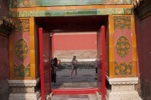 |
 |
 |
 |
 |
 |
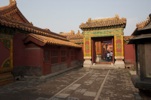 |
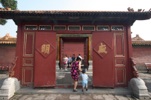 |

 I ended
my day in the Forbidden City by walking around the Zhongshang Park,
an old Buddhist monastery now dedicated to the memory of Sun Yat
Sen. It contains the Altar to the Gods of Land and Grain, where the
Emperor would pray yearly for a good harvest on a field divided by
colored soils into a central, north, east, south and west quadrant.
The park also contains the Laijin Yuxuan restaurant, which serves
authentic old fashioned Buddhist vegetarian meals. I would
have tried it, but found it closed.
I ended
my day in the Forbidden City by walking around the Zhongshang Park,
an old Buddhist monastery now dedicated to the memory of Sun Yat
Sen. It contains the Altar to the Gods of Land and Grain, where the
Emperor would pray yearly for a good harvest on a field divided by
colored soils into a central, north, east, south and west quadrant.
The park also contains the Laijin Yuxuan restaurant, which serves
authentic old fashioned Buddhist vegetarian meals. I would
have tried it, but found it closed. |
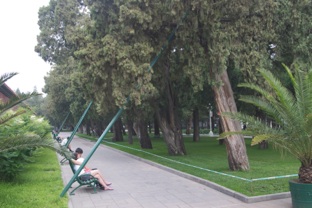 |
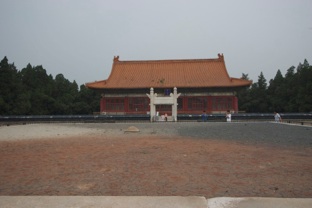 |
 |